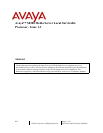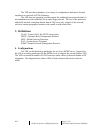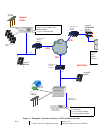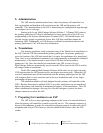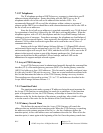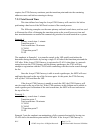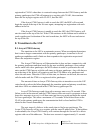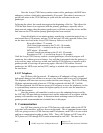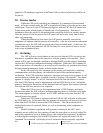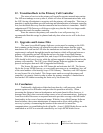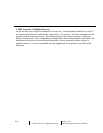
RLC
2003 Avaya Inc. All Rights Reserved.
Page 10 of 12
Local Survivable Processor S8300.doc
applies for IP telephones registered to different LSPs; no direct calls between LSPs can
be placed.
10. License modes
While the LSP is not controlling any endpoints, it is running in license normal
mode. In license normal mode, the LSP is prepared at all times to provide service when
called upon. Once an Avaya G700 Gateway registers with an LSP, that LSP enters into
license error mode, which permits a limited time of call processing. This timer is
intended to allow the user to fix the problem that caused the failover in a timely manner.
Once the period of time has passed, the LSP enters into no license mode, and will not
allow call processing.
When the problem has been fixed, the LSP must be manually reset and all
endpoints will register with the primary call controller. After the reset and no subsequent
registrations occur, the LSP will once again enter license normal mode. At this time, the
license timer will be reset and the LSP will be ready for a new period of time of service
in the event of another failure.
11. Alarming
The LSP will raise several alarms to alert services that the LSP is in service and
that there is a problem either in the network or with the primary call controller. These
alarms will be sent out through a modem or through SNMP over the Internet, depending
on how the LSP has been administered during installation. While the LSP is running as
either a non-active call controller or as an active call controller, any problems discovered
through normal maintenance checks will also initiate alarms.
Each LSP sends keep alive messages to the primary call controller, continuing
communications with the primary call controller as part of the translation transfer
mechanism. If the LSP sends three keep alive messages and receives no response, it will
raise an alarm to indicate that it is unable to reach its primary call controller. This alarm
appears in “display alarms” as an ICC alarm and shows the time the alarm was raised.
The host G700 Gateway must be administered with an S8300 Server in the ‘add media
gateway’ form before this alarm will be displayed and will appear three minutes after the
first time the LSP does not receive a response.
When the LSP receives its first registration from a G700 Gateway and enters
license error mode, the LSP will raise an alarm indicating that it is in license error mode.
This alarm appears in “display alarms” as LIC-ERR, and shows the time that the LSP
entered license error mode.
When the G700 Gateway registers with the LSP, the LSP will raise an alarm that
the H248 link is up. At the same time, the primary call controller will raise the converse
alarm that the H.248 link is down to that G700 Gateway. This alarm should aid in
finding the location of a network failure, as well as determining where endpoints are
registered.
Each IP telephone registration will generate a warning on the LSP. Since
warnings are not called out, this warning will only be seen when it is actively looked for
and is only intended to assist in finding where each endpoint has registered. In addition
to following the warnings to find which IP telephones are registered to the LSP, the
command ‘list registered’ will display a list of extensions that are currently registered.



